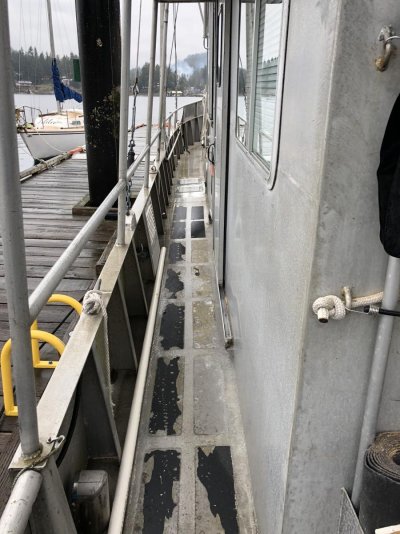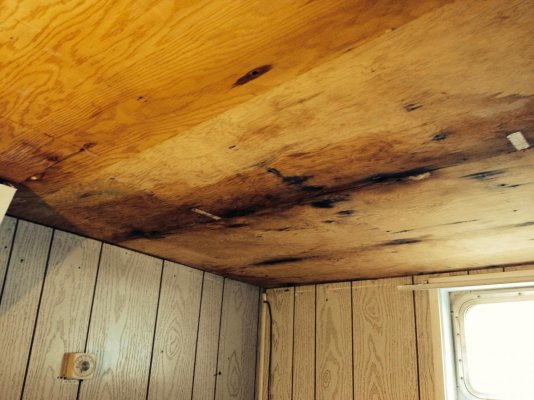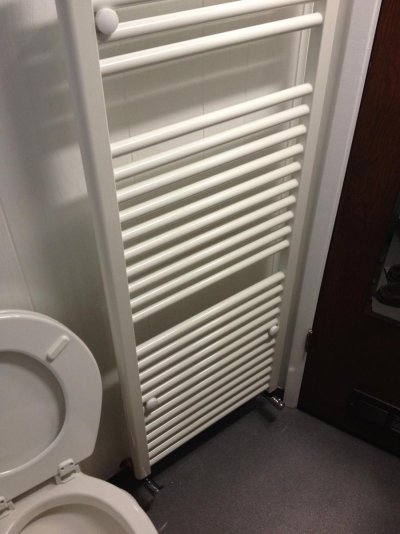Thanks for your comments. A Gardner I nearly bought captivated me with its slow, (350 rpm) smooth and steady idle.
My boat is 43 years old and is in the process of being “improved.” This is the condition of my decks currently with stick-on tread. Its incredibly difficult to remove, leaves glue residue and corrosion underneath. I am trying to find somebody with a dustless sandblaster to blast the decks clean and provide a non-skid surface. I personally will never paint or glue anything on them again and have been trying to find a solution. Modern boat builders may have found the solution but so far I haven’t. I have no idea how long these treads have been on there, I’m in my 5th year of owning “Old Shiny.”
That picture of the aluminum boat I posted had been blasted all over except for a taped border around fittings and openings, leaving a shiny frame. Nice solution. He, however, painted his decks with no-skid....
My roofs have freight decks installed, essentially providing double decking which provides a very cool interior in the hot sun. Even thought the ceiling is insulated, feeling the heat come through where the double decks are not installed is remarkable. Think of a Land Rover with a tropical roof.
Quite right XSBank those low revs of Gardners really captured my attention as well. Our 6LXB redlines at about 1800 and I think we will most likely run her around 12-1400 on passages at about 10 knots most of the time. With the CPP we can dial in ideal load and maximize efficiency at pretty much any speed we want so it will be very interesting to see what our real data tells us about fuel burn and overall performance once we launch and get out there testing and exploring with her.
Thanks for sharing the photos of your work on cleaning up the decks, looks like a nasty job. Was there much corrosion or was it more so the deterioration and wear of the non slip material that prompted you to remove them? Dustless blasting would work but not sure they’d let you do that while in the water? Have you tried one of those scrapers on the end of a propane torch as a way of taking off the majority of the glue and tread material? That or some chemical solution might work best if you’d like to keep her in the water as you’re cleaning it all up.
As with you I don’t know of a better solution than the glued on synthetic material. I’ve spent a reasonable amount of time over the past few years traveling to shipyards and yacht builders around the world and have not seen anything new or different on their boats for this. High end super yachts and the like often go with teak on decks, and the company here that we are building with uses faux teak on some of their boats which is really a variation on the “TreadMaster” type material. Painted on non-skid doesn’t work very well for us due to the heat retention of the metal. It is an option and we did this on our previous steel boat with white poly paint and non skid sand. Worked well for non skid and the white kept the deck temps for your feet bearable most of the time in the tropics were we have been mostly the past few years but would still heat up pretty good. The glued on synthetic material seems to cut down the thermal retention and transfer from the metal decks on boats we have been on with this so that seems to be the best option we’ve been able to find.
With your boat being 43 years old and the non skid deck material being of unknown age it is quite possible that it has been on there for over 20 years and maybe we just need to factor that in as the lifespan of this material and plan on needing to replace it every 20 years or so?
You are quite right that keeping the decks bare, no coatings of any kind, is the best solution to preventing corrosion. No water = no corrosion. But I’m not aware of any way of making bare AL sufficiently safe slip wise when walking/working on them. We looked at going with diamond check plate but it has the same heat transfer problems of raw AL and was still not safe enough skid wise for us. Dashew used this on his prototype boat “Wind Horse” and concluded the same thing so they used TreadMaster on all their FPB boats. The key I think as with any coating is the prep and application so our current plan is to be meticulous with this, using the best available adhesive and making sure all the edges are particularly well glued down. Then over the years it would be important to keep an eye on these edges and seal any that show any signs of lifting. So I’m agreeing with you in spirit that nothing would be best but it simply isn’t an option for us until there is either a way to make bare AL sufficiently grippy or there is a new solution all together that comes along. I’m certainly all ears for a better way to create cool non skid AL decks so please keep us posted on your progress with this on your boat.
Our solution for the heat transfer in roofs/ceilings is going to be lots of insulation on all the interior surfaces including all connected structural parts such as ribs, webs, frames, etc. Our previous steel boat was extremely well insulated with spray in foam everywhere and we had extremely little thermal transfer between the exterior and interior of the boat. On one of the refits I repainted the whole hull and decided to go with dark blue for the hull sides and there was no discernable change in interior temperatures even in the very hot areas we cruised for many years in Fiji, Polynesia, RMI, etc. So we are big believers in going overboard on insulation. With the new boat though we are going to bite the bullet and go with EPDM glued to the interior surfaces as it has as close to zero water absorption as you can get of any material we know of. It’s more expensive both to buy and install but insulation is a high priority item so it is smart spending for us.
Thanks again for all your suggestions and sharing your experiences. Hope you will continue to do more.
Wayne




